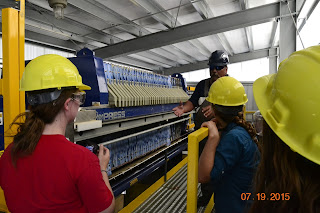The Midnite Mine
Day 9
Before we begin our tour of the
Midnite Mine and Ford Mill, we are all gathered at the library inside Wellpinit
High School. Warren Sailor gave a brief history of the mind and what it meant
to the people of the Spokane Tribe Reservation. Uranium was found by two
brothers of the Spokane Tribe and ran with the help of Dawn Mining Company an
subsidiary of Newmont Mining Company. The cost of running the mine became more
costly than the price of selling uranium especially when the Three Mile Island
had a nuclear accident sending uranium prices down. The mine closed 1981 and
the mining company left the site leaving radioactive material exposed as
explained by Twa-le Abrahamson the Native Air Quality Director/radio host. It wasn’t
till the tribe had to sue the company to come back and clean up their mess
which was until 2001.
The second part of the talk was
safety regulations and the Midnite mine director Randy Barnes had us sign a
release form for enter the radioactive sites. As a Superfund site and the only
one of its kind in the Pacific Northwest that is uranium mine, the government
and Dawn Mining Company are funding to clean up the site. Several worries are
that we reach an area that is radioactive and we inhale the radio activity into
our lungs which will remain with us for our life time. The EPA is overseeing
that the company follows protocols and is not creating a worst mess. Two pits
are exposed that contain water at the bottom that are going through a water
treatment process to be put back into local streams on the reservation. We were
handed a piece of paper explaining to women the health concerns. When Twa-le
asked about health concerns, right away safety specialist Michelle Durum told
Twa-le “It’s on the paper.”
The first site that we were taken to
was the Ford Mill site right outside the Spokane Tribe Reservation with a creek
that separates the two and provides water for nearby houses. We were welcomed
with signs that warn about radioactivity and to keep out. Large areas were
clear cut for large ponds of water to be treated by evaporation. The
radioactive site is surrounded by fence and a nearby hill was hiked to look
down into the mill site. Uranium ores were brought here to be processed and now
over 30 years later remains a problem to the community.
The second site we were taken to was
the Midnite Mine site 25 miles west of Ford Miller. As we drove past dense vegetation
and a dried up area known as Blood Pool because of the red waste that builds
into that area. Twa-le explained that several animals have been found dead near
the water from radiation poisoning. The site is supposedly fenced off but Twa-le
again explained that the site is very accessible from humans or animals. We
reached the site and were divided into two groups one left to the pit while the
other group left to water treatment plant. I was part of the group that entered
the water treatment plant. Several containers provided salts like Barium
Chloride, Calcium Chloride, and Sulfuric acid provided buffers to salt out the
uranium into sludge and change the pH of the water to 7-7.5. The sludge again
will be processed through a filter press that leaves yellow cakes of heavy
metals which will be shipped to Utah be process. Each bag collected will weigh
between 6-8,000Ibs.
Next was the pit. We walked to a
dock that peered down into the giant mine site dug many years ago. The site is
about 500 to 1,000 feet deep. At the very bottom of the pit laid water that was
being pumped thousands of feet to the water treatment plant. 50 millions of
gallons are pumped out and treated each year. Within a year the pit will be
emptied and fill with rock and a protective cover between another layer of rock
and revegetated over the course of 10 years. There is still one other pit north
but much smaller compared to this site. Bacteria in the water is already eating
the uranium and secreting acid into the water changing the pH of the water. Dawn
Mining Company is confident in the project for total safety but Twa-Le was skeptical
along with other environmental critics that studied other state problems. Only
time will tell if the reservation will return to a safe location and drinking water
is not contaminated leading to other health problems.

 Water treated with Hydrated lime
Water treated with Hydrated lime
 Container full of Barium Chloride
Container full of Barium Chloride
 Yellow Cake from the treatment process.
Yellow Cake from the treatment process. Hydrated Lime
Hydrated Lime
 Midnite Mine Pit 3
Midnite Mine Pit 3 Pit 3
Pit 3
No comments:
Post a Comment